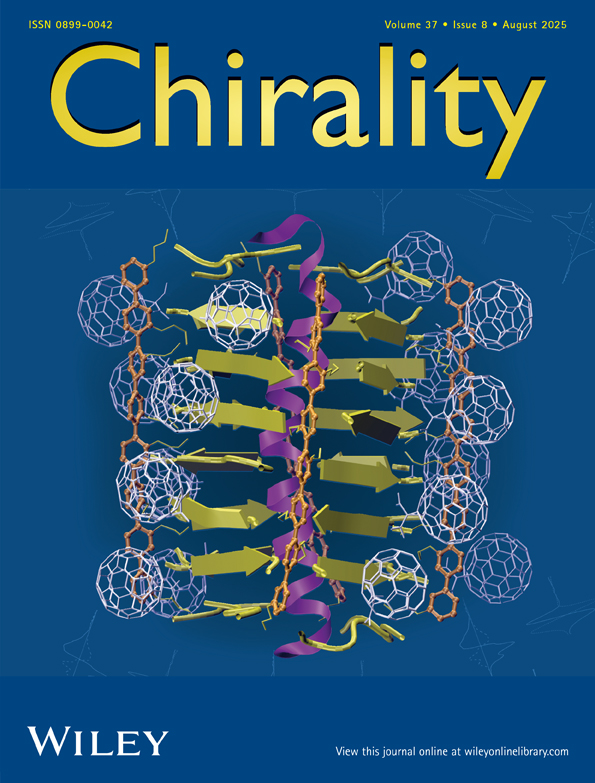Unusual solvent effects on chiroptical properties of an optically active regioregular polythiophene in solution
Hidetoshi Goto
Department of Molecular Design and Engineering, Nagoya University, Nagoya, Japan
Search for more papers by this authorCorresponding Author
Eiji Yashima
Department of Molecular Design and Engineering, Nagoya University, Nagoya, Japan
Department of Molecular Design and Engineering, Graduate School of Engineering, Nagoya University, Chikusa-ku, Nagoya 464-8603, JapanSearch for more papers by this authorYoshio Okamoto
Department of Applied Chemistry, Graduate School of Engineering, Nagoya University, Nagoya, Japan
Search for more papers by this authorHidetoshi Goto
Department of Molecular Design and Engineering, Nagoya University, Nagoya, Japan
Search for more papers by this authorCorresponding Author
Eiji Yashima
Department of Molecular Design and Engineering, Nagoya University, Nagoya, Japan
Department of Molecular Design and Engineering, Graduate School of Engineering, Nagoya University, Chikusa-ku, Nagoya 464-8603, JapanSearch for more papers by this authorYoshio Okamoto
Department of Applied Chemistry, Graduate School of Engineering, Nagoya University, Nagoya, Japan
Search for more papers by this authorAbstract
The chiroptical properties of a novel, optically active regioregular poly[3-(4-((R)-4-ethyl-2-oxazolin-2-yl)phenyl)thiophene] (poly-1) were investigated in mixtures of a good solvent, chloroform, and a variety of poor solvents using CD spectroscopy. Most poor solvents induced CD on poly-1 with similar Cotton effects, while acetonitrile and nitromethane caused dramatic changes in the Cotton effects of poly-1. Chirality 12:396–399, 2000. © 2000 Wiley-Liss, Inc.
LITERATURE CITED
- 1a) Reichardt C. Solvents and solvent effects in organic chemistry. Weinheim: VCH; 1990. p 285–337. b) Suppan P, Ghoneim N. Solvatochromic shifts of absorption spectra. In: P Suppan, N Ghoneim, editors. Solvatochromism. Cambridge: Royal Society of Chemistry; 1997. p 68–95. c) Rughooputh SDDV, Hotta S, Heeger AJ, Wudl F. Chromism of soluble polythiophenes. J Polym Sci Polym Phys Ed 1987; 25: 1071–1078. d) Faïd K, Fréchette M, Ranger M, Mazerolle L, Lévesque I, Leclerc M, Chen T-A, Rieke RD. Chromic phenomena in regioregular and nonregioregular polythiophene derivatives. Chem Mater 1995; 7: 1390–1396. e) Yamamoto T, Komarudin D, Arai M, Lee B-L, Suganuma H, Asakawa N, Inoue Y, Kubota K, Sasaki S, Fukuda T, Matsuda H. Extensive studies on π-stacking of poly(3-alkylthiophene-2,5-diyl)s and poly(4-alkylthiazole-2,5-diyl)s by optical spectroscopy, NMR analysis, light scattering analysis, and X-ray crystallography. J Am Chem Soc 1998; 120: 2047–2058.
- 2a) Patil AO, Heeger AJ, Wudl F. Optical properties of conducting polymers. Chem Rev 1988; 88: 183–200. b) Roncali J. Conjugated poly(thiophenes): synthesis, functionalization, and applications. Chem Rev 1992; 92: 711–738. c) Yamamoto T. Electrically conducting and thermally stable π-conducting poly(arylene)s prepared by organometallic processes. Prog Polym Sci 1992; 17: 1153–1205. d) Berggren M, Inganäs O, Gustafsson G, Rasmusson J, Andersson MR, Hjertberg T, Wennerström O. Light-emitting diodes with variable colours from polymer blends. Nature 1994; 372: 444–446. e) Marsella MJ, Newland RJ, Carroll PJ, Swager TM. Ionoresistivity as a highly sensitive sensory probe: investigations of polythiophenes functionalized with calix[4]arene-based ion receptors. J Am Chem Soc 1995; 117: 9842–9848. f) Roncali J. Synthetic principles for bandgap control in linear π-conjugated systems. Chem Rev 1997; 97: 173–205.
- 3a) Bouman MM, Havinga EE, Janssen RAJ, Meijer EW. Chiroptical properties of regioregular chiral polythiophenes. Mol Cryst Liq Cryst 1994; 256: 439–448. b) Langeveld-Voss BMW, Janssen RAJ, Christiaans MPT, Meskers SCJ, Dekkers HPJM, Meijer EW. Circular dichroism and circular polarization of photoluminescence of highly ordered poly{3,4-di[(S)-2-methylbutoxy]thiophene}. J Am Chem Soc 1996; 118: 4908–4909. c) Pu L. The study of chiral conjugated polymers. Acta Polym 1997; 48: 116–141. d) Fujiki M, Nakashima H, Koe JR, Takigawa H. UV-visible, circular dichroism, and fluorescence spectra of polythiophenes with (S)-methyloctyl side chains. Polym Prep 1999; 39: 523–524. e) Ochiai K, Rikukawa M, Sanui K. Novel highly ordered Langmuir-Blodgett films of regioregular poly(3-substituted thiophene). Chem Commun 1999; 867–868.
- 4Yashima E, Goto H, Okamoto Y. Metal-induced chirality induction and chiral recognition of optically active, regioregular polythiophenes. Macromolecules 1999; 32: 7942–7945.
- 5a) McCullough RD, Lowe RD, Jayaraman M, Anderson DL. Design, synthesis, and control of conducting polymer architectures: structurally homogeneous poly(3-alkylthiophene). J Org Chem 1993; 58: 904–912. b) McCullough RD. Toward tuning electrical and optical properties in conjugated polymers using side chains: highly conductive head-to tail heteroatom-functionalized polythiophenes. J Am Chem Soc 1993; 115: 11608–11609. c) McCullough RD. The chemistry of conducting polythiophenes. Adv Mater 1998; 10: 93–116.
- 6Reichardt C. Solvents and solvent effects in organic chemistry. Weinheim: VCH; 1990. p 51–77.
- 7Langeveld-Voss BMW, Christiaans MPT, Janssen RAJ, Meier EW. Inversion of optical activity of chiral polythiophene aggregates by a change of solvent. Macromolecules 1998; 31: 6702–6704.
- 8Peeters E, Janssen RAJ, Meskers SCJ, Meijer EW. Optical activity of chiral π-conjugated oligomers and polymers. Polym Prepr 1999; 40: 519–520.
- 9The inversion of ICD patterns of a chiral PT during titrations was also reported by Bidan et al. using methanol as a poor solvent: Bidan G, Guillerez S, Sorokin V. Chirality in regioregular and soluble polythiophene: an internal probe of conformational changes induced by minute solvation variation. Adv Mater 1996; 8: 157–160.




